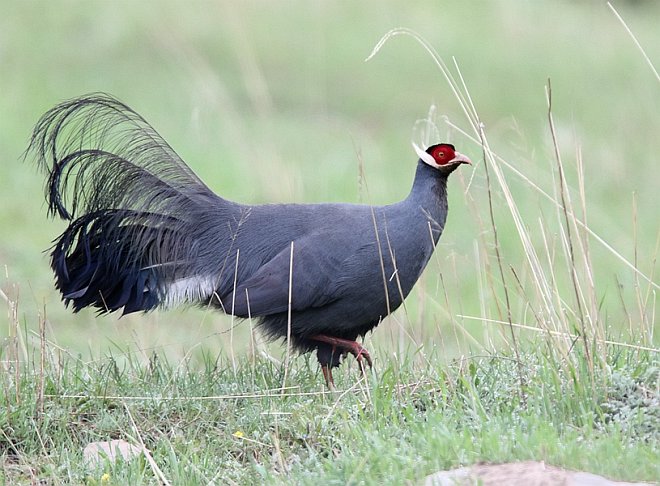Blue Eared Pheasant
Crossoptilon auritum or Blue Eared Pheasant is another wonderful pheasant species from the avian rich forests of China. Blue Eared Pheasants are large and chunky birds. They are mostly a rich blue-gray color, but with bright red facial patches and distinguishing white tufts (or ear coverts) along the sides of the head. The top of the head is highlighted by dark blue-black coloring that matches the darker blue-gray of the full tail. Tails are made up of 24 feathers, and are rooster-like in style, but airier and more gracefully flowing. Legs and feet are scarlet and match the facial patches.
Males and females are very similar in both plumage and coloration. But they are relatively easy to distinguish as males look a bit more coarse. Males are larger, with thicker legs, and rounder and larger wattles. By four months old, males and females will also develop spurs, which will help in determining the birds' sex. Males will have larger, more rounded spurs, and females will have much smaller and oblong- shaped spurs.
Juveniles are gray as well but mottled with brown colors and attain their adult coloration by four months old.
Blue Eared Pheasants are vocal and amiable birds. They are loud, and males make a very grating series of sounds that can carry over a mile. The male's initial calls are usually answered with equally loud calls from his mate or other rival males. Although pheasants in general tend to be a bit standoffish, Blue Eared Pheasants are one of the friendliest of species and have been known to approach their caretakers and eat out of their hands.
Range: The Blue Eared Pheasant is a mountain fowl and is found through out the mountainous forests of inland, central China.
Habitat: These are a high altitude species of pheasant, usually found in coniferous forests up to 11,500 feet in elevation. Blue Eared Pheasants are winter hardy and able to withstand harsh weather.
Status in the Wild: Blue Eared Pheasants are one of China's most common pheasants, and as such, it is listed as being of Least Concern on the IUCN Red List of Threatened Species.
Status in Aviculture: Because of their hardiness, ease of care, and charming temperament, Blue Eared Pheasants are very common to find in captivity. They would be good 'beginner pheasants' as they are both calm and uncomplicated to raise.
Breeding and Incubation: It is best to keep Blue Eared Pheasants as pairs as they are monogamous, and pairs form very strong bonds. Males can get aggressive and protective of their mates during breeding season, which is generally April to June. Although one-year-old Blue Eared Pheasants will start laying eggs, better breeding results will be obtained with two-year-old pairs. Nests are made on the ground, and clutch size is 6-12 eggs. Incubation takes about 26 days.
Lifespan: Blue Eared Pheasants can live 12 -15 years and perhaps older.
Size: These are large pheasants, with males being over 3 feet in length (38 in), and females usually being slightly smaller.
Housing Requirements: Like most large pheasants, Blue Eared Pheasants will need a spacious aviary or enclosure. Pens should measure at least 20 feet wide by 12 feet long. Tops would be recommended against predators, but in general Blue Eared Pheasants are not great fliers. Tops for shade would also be highly suggested as these are forest-dwellers and should not be overexposed to direct sunlight.
Providing large logs for perching and shrubbery and other large vegetation would be a nice addition to the aviary. These birds are cold hardy, but shelter should be provided against storms and wet weather. In general, Blue Eared Pheasants do not do well with dampness. Make sure the enclosure is well drained.
Blue Eared Pheasants are diggers. They use their strong beaks for digging, and they will ruin smaller plantings in their aviary. Designing your pens around larger trees and shrubs would be recommended.
Diet: A high-quality commercial game bird diet is fine, but be sure to supplement your birds with other diverse, nutrient-rich extras. Examples of such extras would be mealworms, greens, wild bird seed, tubers, nuts, or cat or dog kibble. In the wild, Blue Eared Pheasants dig up most of their diet, which is mainly made up of leaf shoots, insects, bulbs and tubers, and roots.
Miscellaneous Notes: Unlike chickens and most other fowl which dig using their feet and legs, the Blue Eared Pheasant digs using its huge beak. They are, in fact, extremely effective diggers, and that must be taken into consideration when planning and designing their enclosure.

